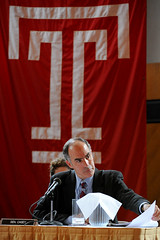U.S. Sen. Bob Casey takes the floor at a Temple-hosted Congressional hearing on affordability.

U.S. Sen. Robert Casey Jr. said expanding the federal Pell Grant was the most important step in encouraging more low-income students to attend college, after chairing a Congressional hearing on college access at Sullivan Hall yesterday, Oct. 5.
“It’s been said education is the great equalizer,” Casey said in his opening statement. “But we cannot say that if more of our students don’t have access.”
The 1 p.m. public hearing, held under the Senate Committee on Health, Education, Labor & Pensions, featured seven witnesses, including three college students, a parent, two college professors and Senior Vice President of Finance and Administration for Temple Anthony Wagner.
The college students, from the University of Pennsylvania, Cheyney University and Penn State University, relayed their stories of dealing with financial aid throughout college.
“Many times, people don’t realize how many additional costs there are,” said D.J. Ryan, a junior at Penn State, detailing his struggle through college funds used for family medical emergencies and having to transfer colleges in order to live at home. “The scenario I face is simply unfair.”
Dr. Andrew Gillen of the Center for College Affordability and Productivity said one of the problems with affordability is that colleges were raising tuition and spending more money on expenses other than teaching students. He cited scholars who had referred to universities as “cookie monsters” because they tend to continually spend more money, raising tuition as they spend.
Wagner said part of the continual rise in tuition and fees stems from a dwindling percentage of state support.
“I don’t know about the arms races between elite private universities,” Wagner said, pointing to the fact that between 1972 and 2009, the percentage of public schools’ budgets that came from the state decreased from 60 percent to 20 percent.
Gillen said one of the first things colleges need to re-examine is what their purpose is, instead of being institutions that cater to research, liberal arts education or professional schools, such as law and medical programs.
“They are trying to do all of that, and are spending gobs of money doing it,” Gillen said.
Dr. Laura Perna of UPenn and Gillen said access to all the money available to students for college needs to be simplified. The FAFSA form is too complicated and cumbersome for low-income students, whose parents have little experience with financial aid, they said.
“It’s written in arcane government language and it’s impossible to decipher,” Gillen said.
The consensus of the witnesses seemed to be that the direct and indirect costs of college have become too much of a burden, and that there needs to be more aid and better access to the aid that is available now.
“Other than healthcare, there are very few costs that have gone up [like higher education],” Wagner said.
Casey said after the hearing that the Pell Grant would be a major focus of his efforts on education and affordability.
“Student lending will be a big part of the debate [as well as] expanding the number of students who can afford to go to school,” Casey said.
Stephen Zook can be reached at stephen.zook@temple.edu.


Great post that covers the subject matter in detail